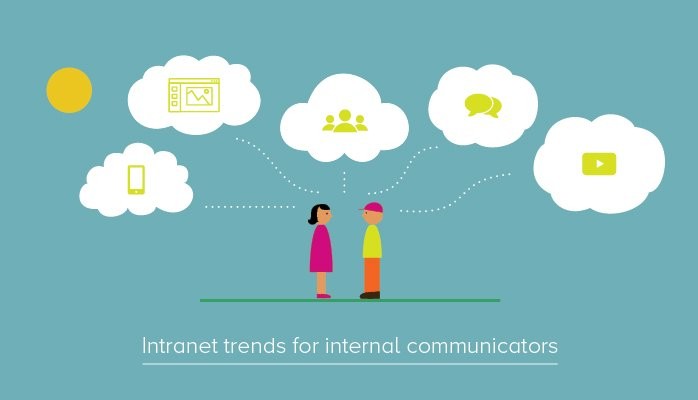
Intranet trends for internal communicators
Let's talk about what's changing in how we communicate.
When it comes to intranets and employee portals, a lot has changed recently for internal communicators. Here is a quick summary of some notable shifts worth discussing:
- Internal communicators have a broader accountability
- The role of the intranet manager is changing
- The new digitally fractured workplace presents new challenges
- Enterprise social is still finding its place
- Employees want authentic communications in real-time
You can also read my sequel post: More intranet trends for internal communicators.
Internal communicators have a broader accountability
For many communicators, the sandbox is growing. The internal target audience is growing. The channels are increasing. It’s not just about communicating to the office worker anymore-- mobile and field workers are now in range. It’s also not just about managing homepage news either. Instead, internal communications teams help craft strategic communications for departments, executives, enterprise projects, change initiatives, and more. The intranet continues be a primary channel for deploying these communications, but it is not the only one that matters anymore.
The role of the intranet manager is changing
For some organizations, the role of the intranet manager is being reframed as a digital workplace manager, although it remains unclear exactly where this person should sit in the org chart. Are they in PR/Comms? Are they in IT? Are they in HR? I happen to feel they should live in communications, but I don’t think it really matters. What does matter is that they are a strong advocate for the employee experience and can bridge a vision across HR, IT and communications, shaping a modern view of the digital communication and collaboration landscape.
The new digitally fractured workplace presents new challenges
With the introduction of so many cloud based tools and the evolution of Office 365’s NextGen Portals for communication and collaboration, we’ve entered into a world where capabilities massively overlap across technologies and vendors. For many organizations, more tools isn’t always a good thing.
Despite a recent Gartner news announcement saying "Today's employees possess a greater degree of digital dexterity," I think we still have a tough road ahead to help employees make sense of their digital options.
Businesses need internal communicators to work side-by-side in partnership with HR and IT to carefully craft a new information management strategy to bring clarity to employees and solve real business challenges. Communicators need to help establish the ‘what tool, when…’ playbook and help make sure all this market innovation doesn’t stall or impede the success of internal collaboration.
Enterprise social is still finding its place
Enterprise social networks have gone through a traditional hype curve’s peak of inflated expectations and may now be rising out of the trough of disillusionment, although it’s not clear many companies are feeling enlightened yet. If you haven’t adopted an enterprise social network or infused your intranet with some kind of social capability, then I’d imagine you are getting ready to make sense of it soon. Between Jam, Jive, Yammer, Slack and other great tool sets, they all really support the same type of experience. Communications generally needs to decide if they want to be a driving sponsor of the employee community and use the network to their advantage. Or instead, they must choose how to leverage it within the context of their intranet communications.
For the past two years, Microsoft has given clear guidance that it’s better to invest in Yammer instead of investing in SharePoint’s social capabilities. Going forward, it seems pretty clear that they are moving to a more integrated experience with Social plumbing into the entire Office and O365 fabric.
Employees want authentic communications in real-time
Perhaps this has always been the case, but more than ever it seems employees expect to have answers at their fingertips. They want the straight goods too, no beating around the bush. If a topic has made it to the proverbial water cooler, you should probably consider having a position on it soon in the next official internal communication. The question communicators need to grapple with is which channel should they leverage to get involved in the conversation? Important to note, some companies that are really on top of their internal Social networks are on top of the conversation before things really ever get out of hand. Great communicators need to also be great listeners and decide the best channel to connect with their audience!
Since posting this, I've had some great conversations and decided to add a few more to the list. You can see More intranet trends for internal communicators here.
--------------------------------------------------------------------
I talk about intranets, internal communication, employee engagement and other digital workplace trends impacting businesses today. I love hearing new thoughts on those topics so if you'd like to continue the conversation, connect with me here or find me on Twitter at @chrisradcliffe.
To learn more about what I do or see samples of our most recent work, check out our case studies and insights at Habanero or contact us.
Director of Enterprise Social Media Strategy, Elevance Health
8yYour point about developing a 'what tool, when' playbook is an excellent one, Chris. It's not enough to just put the tools out there; we have to help end users imagine how they might use the tools, and make good decisions about the best tool for the job at hand.
Thanks James!
Building Customer Experience for Viva Engage & Answers in Viva at Microsoft | Facilitator & Network Builder | Author of 'Social by Design: How to create and scale a collaborative company'
8yGood post Chris!